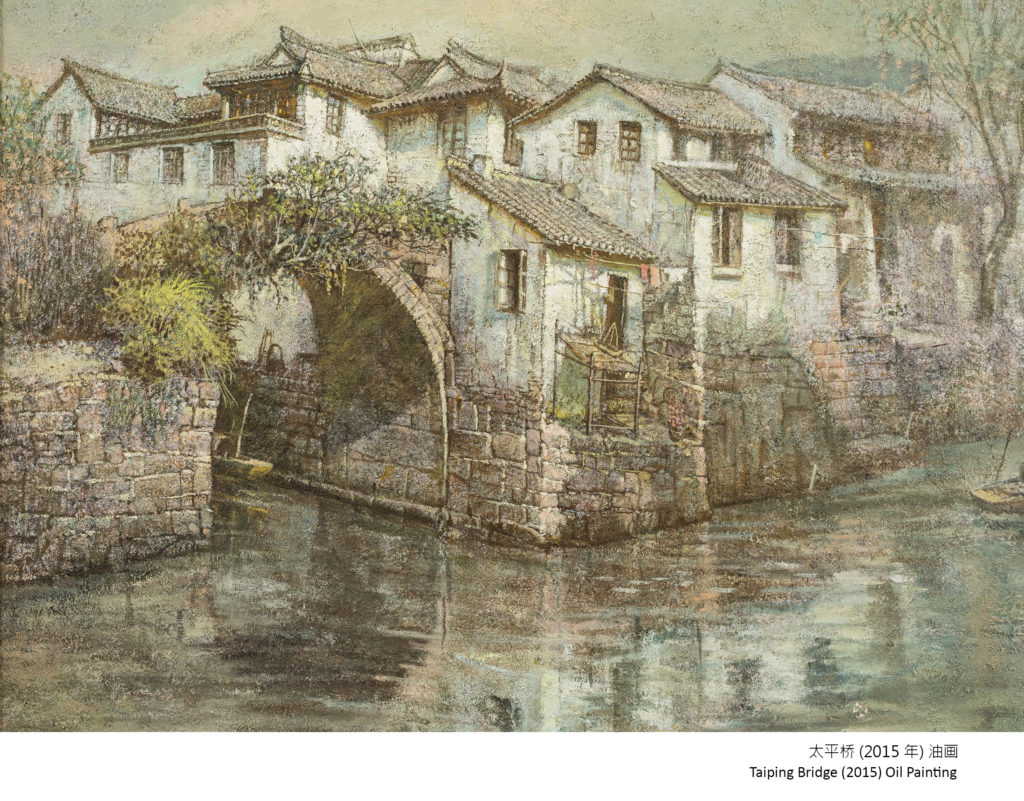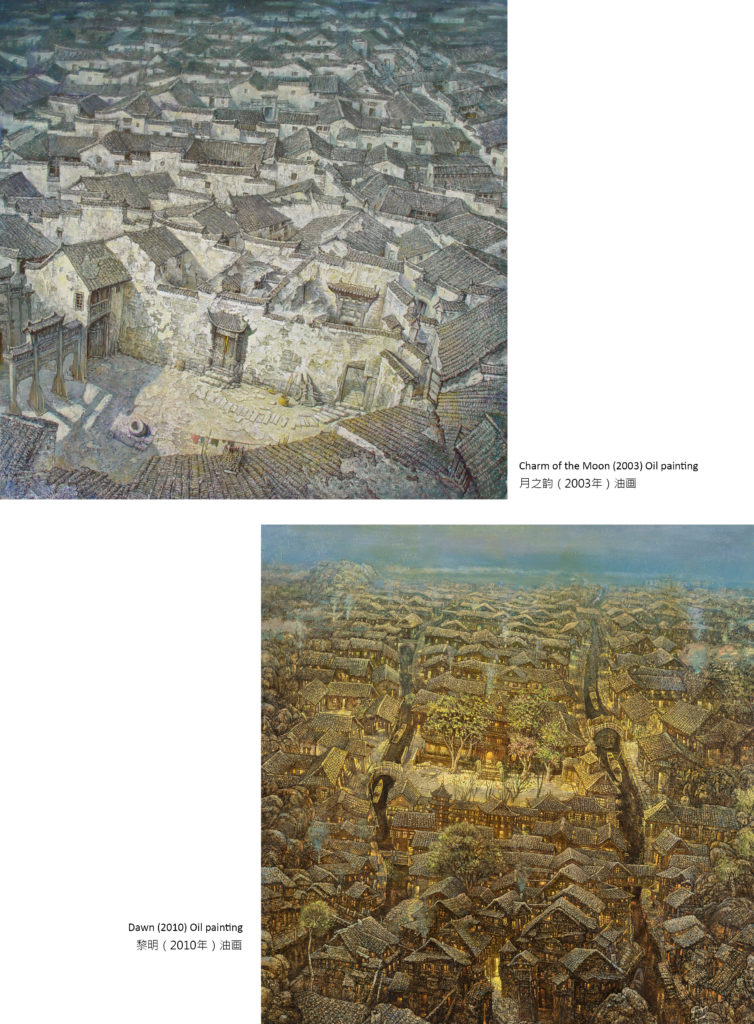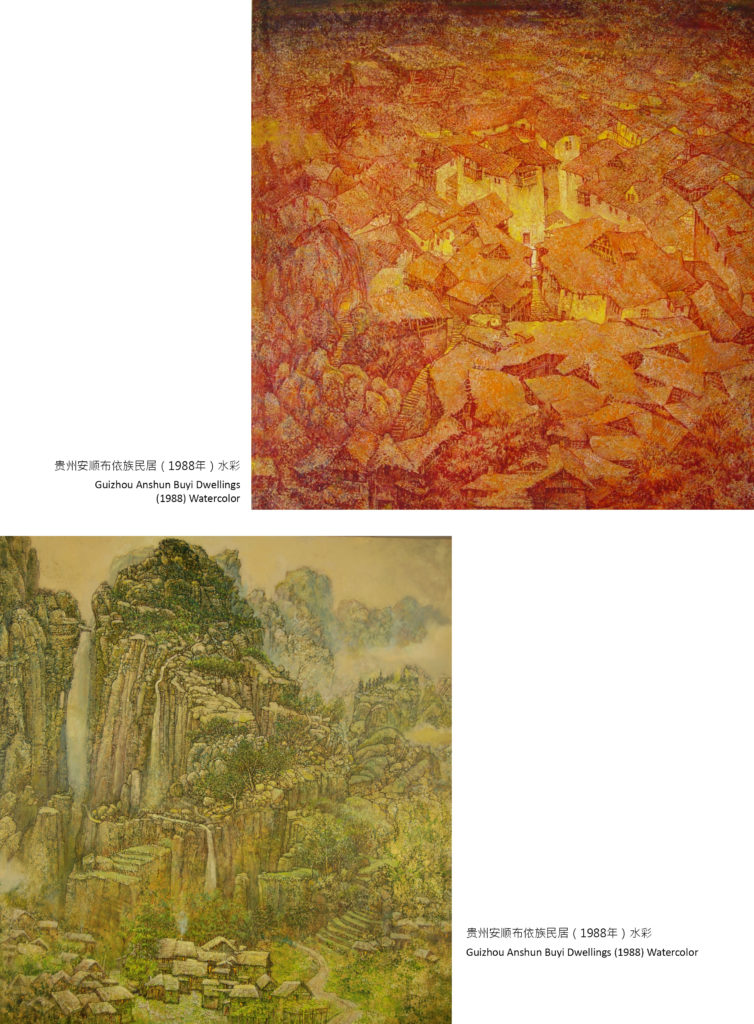Introduction to Dialogues
Interviewer — Wu Shu — Famous writer, cultural scholar, and senior reporter in China
Interviewee — Yu Chunming — Famous painter residing in the United States. After graduating from the China Academy of Art in 1982, he taught at Jiangxi University. In 1996, he was invited as a visiting scholar to lecture at American universities and then settled in the United States. He is currently a professor and museum curator at the School of Art and Design at Nanchang University.
For decades, no matter if he is in the East or West, Prof. Yu Chunming has a special liking for the cultural heritage of the Chinese people. He continued to travel across the country to study ancient dwellings, completed special sketches of more than 3,000 paintings, and hundreds of featured paintings. He is hailed as the “China’s Residential Culture Preservationist” and “The pioneer in Chinese folk painting series.” His works have been highly regarded by the art critics and sought after by domestic and foreign collection agencies and individual collectors. The world’s influential collection agencies such as the China Art Museum, the US Stanford University Library, the Nagasaki City Art Museum in Japan, and British Prime Minister Chakier, as well as private collectors from the United States, Britain, France, Germany, and Japan. The U.S. Postal Service twice printed his oil paintings on the Primary Day Covers of major events and important holidays.
An Old House – No Way Back
The passage of time had left a deep imprint on painter Yu Chunming – every dignified brushstroke was slow and heavy as if met with great resistance. Even seemingly easy straight lines were drawn with a trembling backward-pulling stroke. When this uniquely Eastern brushwork is fused with the embodiment of dreams, a sense of history and legend blossoms involuntarily as the magical stroke of the brush chases the path of Hesiod.
—— Fan Jingzhong, Professor, Ph.D. Teacher, China Academy of Art, renowned art historian
Depictions of Chinese dwellings are different from ordinary landscape paintings. They are the most representative paintings that can reflect the traditional Chinese cultural connotations. Yu Chunming is second to none in all of China, in portraying the comprehensive appearance, environment, and connotation of traditional Chinese dwellings.
—— Zhou Hongxiang, Professor of UCLA East Asian Language and Culture Department, USA
So far, no Chinese painter has reached the depth and breadth of Yu Chunming in grasping the relationship between humans and their settlements. More than 20 years of persistent exploration, have resulted in a simplicity and realism merged flawlessly in his freehand brushwork.
Wu Shu: Your dwelling paintings have caught the eye of the art collectors and critics of both the East and West. I would like to know, what kind of path you took all these years?
Yu Chunming: In 1978, after the entrance exam, I attended the Chinese Academy of Art to study and after graduating in 1982, I taught at the Department of Architecture of Nanchang University. In 1996, I was invited by UCLA as a visiting scholar and settled down in the US. Since my graduation from art school, I was dedicated to exploring my personal style, working day and night on my artwork, making countless attempts throughout the year with no accomplishment because all I can draw is what I know already. What I know was almost entirely the style of others.
In the summer of 1983, I went to the mountainous area of southern Anhui, with feelings of distress and sorrow. When I got out of my car, I was stunned by the unique scenery there. The century-old houses, one after the other, situated along the hillside and bodies of water, creating villages here and there. Due to exposure to the sun and rain, the original dull and uniform look of the residences, with white wall and black tile rooftop, all worn out, created a beautiful view that is rich in texture and classic shape formations. I sauntered in the alleys and stepped on the bluestone slabs that traverse hundreds or even thousands of years; with each step, the feeling of vicissitude increased, along with my heartbeat. There was no painting or object in the past that created this lasting impression on me, isn’t this the painting subject that I have been searching for all these years? Perhaps this is fate. From then on, I willingly carried this great “burden” of traditional Chinese heritage. I decided to use paintings to mark sections of history and since I started painting this subject, more than 20 years have gone by, in which I visited 56 ethnic groups in China with ancient houses of local characteristics.
I spent more than a decade traveling through the vast rural towns and villages of China, painting more than 3,000 small sketches, taking tens of thousands of photos, and writing a “local residence” column in the overseas edition of the People’s Daily. I started to write books and participate in the folk house and folklore seminars, hoping to arouse people’s sense of responsibility in protecting ancient Chinese dwellings. I was on the road for two months each summer, the travels were strenuous and dangerous, not to mention that I was also heavily indebted. What was even more painful was that few people understood my work. The government did not support, the work was unstable, and the social reaction was indifferent. Even the China Youth Daily, which has dared to pursue new trends, refused to publish my residential research articles and paintings; they said “drawing debilitated houses reflect the dark side of socialism.”
Wu Shu: Have you ever consider switching topic completely?
Yu Chunming: It may be because of my character. Although this path is long and hard, and I often feel the road may lead to nowhere, but the Chinese dwellings in the north and the south are like a treasure trove of aesthetics, they alone are enough to help me remain focused on my mission. After more than ten years of research and sketching, I spent another twenty more years creating hundreds of paintings depicting more than 30 typical residential environments and various old houses in China.
Wushu: I feel it is difficult for an oil painting to master the monochromatic white walls and black tiles of the folk houses along the patchwork waterways of rivers and lakes. This is especially since oil painting is a type of painting that came from the West and has its own cultural roots. It is rare for the fusion of two different painting traditions to be successful, isn’t it?
Yu Chunming: Quite the opposite. I was deeply moved by the ambiance and spirit of folk houses and found that the familiar traditional watercolor and general painting techniques were lacking in what I wanted to express. This prompted me to use a different technique for expression. I was engaged in the creation of lacquer painting at that time and was inspired by the ‘separation of oil and water’ technique. I tried using a combination of oil pastels and watercolor techniques to do a quick sketch of folk houses and got unexpected results. I just wanted to express the feelings which folk houses give me and I’ve never deliberately pursued a personal ‘technique.’
From One Shore to Another – Transformation
After immigrating to the US in 1997, Yu Chunming did not follow the commercial market trends in a fiercely competitive business environment. Instead, he continued what he had fought for more than ten years – artwork with folk houses as his subject.
Vivid spatial relationships and scatter perspectives of traditional Chinese paintings can be seen in his works, as well as Chinese brushstrokes, ink painting, and Chinese lacquer painting techniques. After coming to the West, in order to better integrate into Western culture and increase the universal value, he infused his paintings with Rembrandt-esque chiaroscuro while making use of the transparent color rendering techniques of classical painting, lending his painting an international voice.
—— Dr. Shao Dongfang, Chief of the Asian Division, Library of Congress, USA
Yu Chunming is an artist who melds two worlds together. In addition to his understanding of traditional Chinese art forms, he is also greatly influenced by traditional Western art, especially the artists of the Baroque period. His painting style combines Eastern portrait painting, landscape composition, and scattered perspective. He makes use of chiaroscuro, controlling light and dark while paying great attention to detail to express the emotional power of light and shadows.
These works hold a great amount of cultural symbolism. The audience may not be familiar with the location of these folk houses but they, without doubt, showcase a community with a long history and rich cultural heritage. The artist is familiar with the subject and the downward perspective helps the artist in peeling away the distinctive features of the village, while the monochromatic elements and symbolic Baroque techniques bring something familiar to Western audiences, allowing audiences of different cultural backgrounds to identify with the painting.
Wu Shu: How did you integrate your own paintings into the local American art market and also gain the recognition of the mainstream art circles?
Yu Chunming: The traditional Chinese concepts I want to express are not understood, not just by Americans but also the Chinese people of today. I need to take what I want to say and turn it into a language which everyone would know and love. What my painting conveys is a universally meaningful culture. Achieving this is extremely difficult and one must first identify the cultural differences between traditional artistic styles. Dr. Yang Siliang, who studied Eastern art history at Kansas State University, USA, stayed at my home for a short time once. He looked at my paintings and said, “Your paintings have traditional Chinese flavor and significance and have Western spatial relationships but there is no light. You have to add light to your paintings – this is America after all.” Dr. Yang’s words were enlightening. After that, I deliberately alienated the native culture and historical ecology, ‘looked back at it from another shore’, and did a comprehensive reassessment and reflection on the differences between Eastern and Western painting techniques.
Between the art systems of East and West, the West focuses on ‘light’ to express the subject, establishing a sense of order in the shape of objects and people, and using it to express ‘God’ – the Creator. Light represents God in Western art. In Eastern art, the focus is on the ‘qi’ (essence) of ‘things found in chaos, existing before Heaven and Earth’ (The Book of Dao), aiming to reach the ‘dao’ (way) through the expression of ‘vivid character’. Eastern and Western art use their respective approaches and forms to render their own ideas of Dao or God. Light on objects is visible and one can interact with it but qi is intangible. Westerners generally do not have an understanding of qi and Easterners do not easily understand the connotations of light in the West either. ‘How can I make a connection between the two and let there be qi in light and light in qi?’ This was the first new topic I set for myself after arriving in the US.
It was not easy to find a good balance between the language of ‘light’ in Western art and the language of lines and space in Eastern art. I tried putting light into textures, lines, and spaces to express humanity, experiences of life, a reflection of life, the warmth of home and so on. While choosing elements of Chinese painting which would blend easily with Western painting, I found that I could only combine the shades of East and West if I returned to the Tang and Song dynasties. Paintings from those periods strongly emphasize the connection between nature and spirit. There were no new innovations for hundreds of years after the Song dynasty and paintings from then do not have natural elements as a foundation. Paintings had become an illustrative form of expression to emphasize, vent or reveal the subject’s nature and ambition. The Tang and Song dynasties, on the other hand, were in a stage of diversification and unrestrainedness; many art techniques were frequently exchanged with the West. I discovered during my research that there seem to be similarities between the composition and style of background landscape in Early Renaissance oil paintings and Song dynasty watercolor landscapes.
Wu Shu: I also noticed in recent years that collection of your paintings of folk houses have grown rapidly. Even the former prime minister of the UK, Baroness Thatcher, had your artwork added to her collection.
Yu Chunming: After more than ten years of exploration and experimentation across the Pacific Ocean, working hard to combine the nuances of light and qi in the art of East and West and merging the two to create my own painting style, what I find most comforting is that I finally found my own Dao of art – using oil painting and ink painting to express China’s ancient dwellings.
When East meets West, a mixing of lines, light, and space happens. It is the contrast between ink and layers of light and shadow, the fusion of Chinese aesthetic concepts of diligent life-long study in their world of brush and ink and the Western aesthetic concept of reflecting a worldview with the light of God through a visual sequence. Oil painting can also express the artistic mood of ink paintings but it cannot replace the medium of ink painting – this is its unique aesthetic value. The core values of all art forms should transcend the worldliness of regional cultural traditions; they belong to all mankind.
For more info or to purchase works by this artist, please contact us at info@ensemble.cc










Be the first to comment